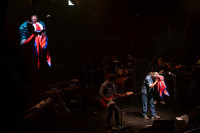Entertainment
The missing link
The exhibition is a meditation on belonging and not belonging, with repeating imagery of self portraits and floating astronauts against beautifully muted, distilled, sea blues and rose pinks juxtaposed against eerie land and seascapes
Sophia L Pandé
The Park Gallery in Pulchowk, tucked away in a quiet narrow lane, is currently hosting a conceptually interesting, visually pleasing exhibition by the young but veteran artist Saroj Bajracharya, a marketing student turned painter who also curates and writes about the arts.
Bajracharya’s exhibition, his fifth solo show, is self-curated and consists of 10 medium sized acrylic paintings that hang on the ground floor supplemented by another four paintings and an installation on the second floor. Titled The Missing Link, the exhibition is a meditation on belonging and not belonging, with repeating imagery of self portraits and floating astronauts against beautifully muted, distilled, sea blues and rose pinks juxtaposed against eerie land and seascapes. The astronauts signify a detachment from the earth, but also a unification with the universe as they leave the earth’s orbit. Therefore, even as they drift away from our planet they move into another, perhaps a more inclusive realm that may seem more alien but is a space of comfort for those, like the artist, who are seeking meaning from the world.
The ten pieces on the ground floor complement each other, informing and adding to the artist’s self portraits, one of which shows him sitting in a rosy hued room looking skyward, his coffee mug floating in the air beside him with the liquid streaming upwards out of the cup as if gravity had reversed itself—pulling Bajracharya’s thoughts and his beverage, towards space.
What may appear as themes of alienation, or perhaps the inner lonely landscapes of the mind, can also be construed as meditative contemplations, the surreal symbols are ciphers of the artist’s emotions that are not easy to interpret for the viewer, but make the paintings no less interesting because they are enigmatic.
The pervasive imagery of water, fish, and shells all have meaning codified by the artist himself, to mean the affirmation of life, the origin of species, and in the case of the shell, the eponymous missing link from the title of the exhibition. The Missing Link is usually a phrase used to describe the gap in knowledge regarding our evolution from ape to man, but to the artist can also mean the process in between inception and product—a blurry state of consciousness that is usually hard to describe, hence the cryptic paintings.
Fortunately, even as his imagery is complex, Bajaracharya is much more articulate than most artists of his generation, able to speak in depth and at length about his work and about his opinion of the state of the arts in Nepal. As a writer and curator himself, he holds strong views on the lack of structure from teaching institutions, which do not teach art history so that artists can place themselves within a global framework, and therefore, also cannot speak knowledgeably regarding how their work fits into our own historical context.
The artist and the critic within Bajracharya speaks of the politicisation of art, in other words, art is always political on various levels, but Bajracharya feels, strongly, that intense personal feeling needs to be channelled into art for it to be authentic.
It is one’s owns feelings, be they pleasure or pain, that make for a worthy piece. Contemporary art is moving conceptually towards representing the problems of the world and not necessarily the issues of the artist, therefore perhaps losing truthfulness as the artists seek to represent the problems that are not necessarily their own; there is a branding going on, of drawing on other’s issues to make one’s own work relevant.
Whatever one may think of these views, the idea that compassion evolves with evolution, over years, as one channels and focuses one’s feelings on one’s art, is a valid and worthy philosophy to work by. While the exhibition may seem esoteric and inscrutable, there is a humanity that emanates from the works that comes from a thoughtful, disciplined practice. Painted over a year and half, the current show is an exercise in surrealism, each canvas encapsulating a metaphorical existential crisis. You can look at these paintings and see both awe at the universe, pleasure in its mysteries, and pain from the loneliness of not quite fitting in.
Perhaps the most interesting thing about the exhibition is witnessing the effective practice of conceptualism in Nepal. Speaking to Bajracharya, it is heartening to find a thinker who can assess both his contemporaries and himself as well as the critical and curatorial world, and can speak of his own art, with references to Giorgio de Chirico and Edward Hopper, alluding to the silence, loneliness, and heightened symbolism in their paintings that then inform his own.
The paintings and installation from the upper floor are retrospective of Bajracharya’s works from the past, and indicate how far this artist has come in his own evolution, having painted now for over 20 years, culminating in the current exhibition, on till the end of May. The Missing Link is a show by an original, and a signifier of how, in art, the personal can be the most powerful.




 26.61°C Kathmandu
26.61°C Kathmandu










